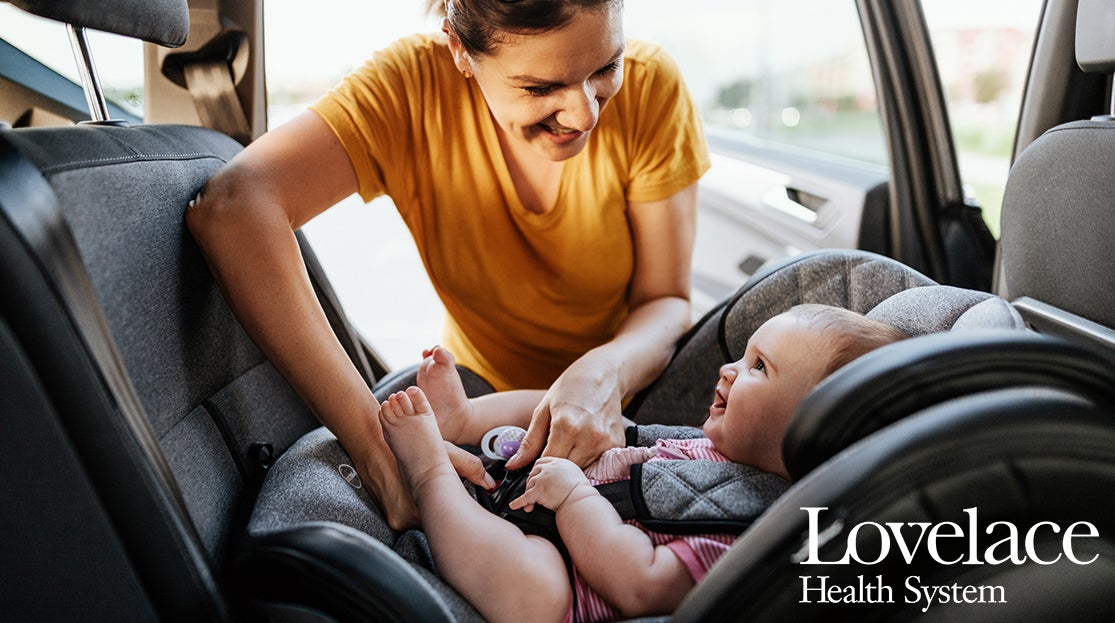
Parents and caregivers of infants, toddlers and older children need to know what kind of car seat must be in their cars to transport their youngsters safely.
Lovelace Health System and Labor of Love is pleased to join the New Mexico Motor Vehicle Department (MVD), the non-profit organization Safer New Mexico Now and other organizations to advocate for safety when driving, especially when children are onboard. The following questions are especially important for your child’s safety.
1. What kind of car seat do I need for my child/children?
The kind of car seat depends upon the age and weight of your child. Below is a list of requirements set by the New Mexico MVD. New Mexico law requires following all manufacturer instructions, including specific height, weight, and age requirements.
> Children under the age of 1 must ride in a rear-facing child safety seat in a back seat. If the vehicle has no back seat, a child under age 1 can ride in a front seat IF the airbag has been deactivated. The National Highway Traffic Safety Administration recommends never putting a rear-facing child safety seat in front of a passenger airbag.
> Children between 1 and 4 years old must ride in a child safety seat.
> Children under 40 pounds must ride in a child safety seat, regardless of age.
> Children between the ages of 5 and 6 must ride in a child safety seat or booster seat.
> Children under 60 pounds must ride in a child safety seat or booster seat, regardless of age.
> Children between 7 and 12 years old must be properly restrained in a child safety seat or booster seat until the adult seat belt fits them properly. The lap belt should stay snug below the hip bones, touching the upper thighs, and the shoulder belt should stay against the chest and shoulder. Your child’s knees should also bend naturally over the vehicle seat edge to help keep the belt in position.
> Teenagers between 13-17 years old and all adults must ride in a seat belt.
Note: New Mexico has a primary enforcement seat belt law and a primary child restraint enforcement law. This means that if a vehicle is stopped for other reasons and if the driver or any passengers are not wearing their seat belts, or children are not properly restrained, the officer can issue seat belt or child restraint violations.
2. Why is a rear-facing car seat safer for infants?
In the event of a head-on collision, the momentum of the car throws the occupants forward. Children in a rear-facing car seat have additional head, neck and back support. If a child is facing forward, their head will be thrown forward, which may cause spine and head injuries.
3. When can my child ride front-facing?
All infants and toddlers should ride in a rear-facing seat as long as possible until they reach the highest weight or height allowed by their car seat’s manufacturer instructions. In New Mexico, children must ride rear-facing in a child safety seat at least until their first birthday. Be sure to check other states’ regulations when traveling through those states.
4. Are there car seat brands that are not approved for use in the United States?
Car seat regulations in the U.S. are different than what is required in many other countries. When choosing a car seat for use in the United States, look for one with a 5-point harness and chest clip. The harness has straps that go over both shoulders, both hips and then buckles between the legs. This harness and chest clip provides the best possible protection for children.
5. Is it okay to purchase a used car seat?
Lovelace Health System and Labor of Love do not recommend buying a second-hand/used car seat.
If a family insists on purchasing a used car seat, Safekids.org gives the following suggestions:
Purchase a used car seat only if you:
- Know the full history of the seat and can be 100% certain it has never been in a crash.
- You can look up the manufacturing information on the seat’s labels and determine that it has not been recalled.
- Confirm the car seat's expiration date. This is usually located on the seat or you can check the manufacturer's website.
- Check the car seat to make sure there are no missing parts and that the harness connects easily.
Note: Your family may qualify to receive a child safety seat at a low cost.
Funded by the New Mexico Department of Transportation Traffic Safety Division, the New Mexico Child Safety Seat Distribution Program (NMCSSDP) helps provide car seats to low-income New Mexico families as well as education on how to properly use them.
There are approximately 40 distribution locations statewide and each site has specific qualifications families must meet before being issued a seat.
For more information, visit the Safer New Mexico Now website or call Lovelace Labor of Love at 505.727.7677.




